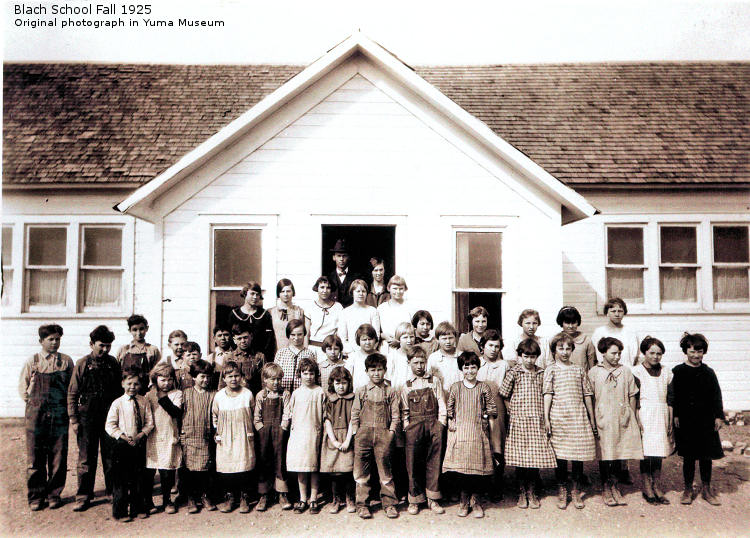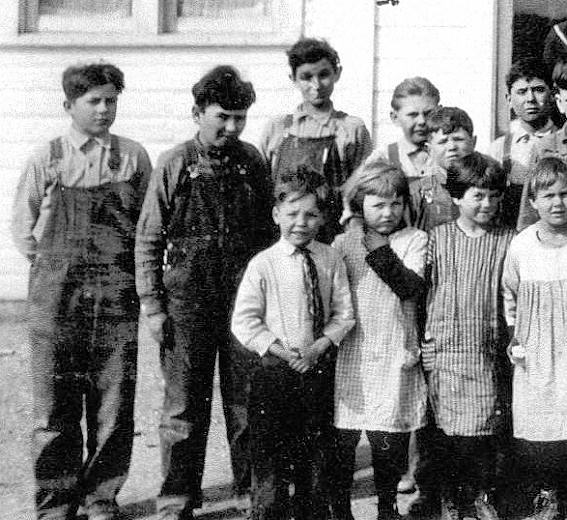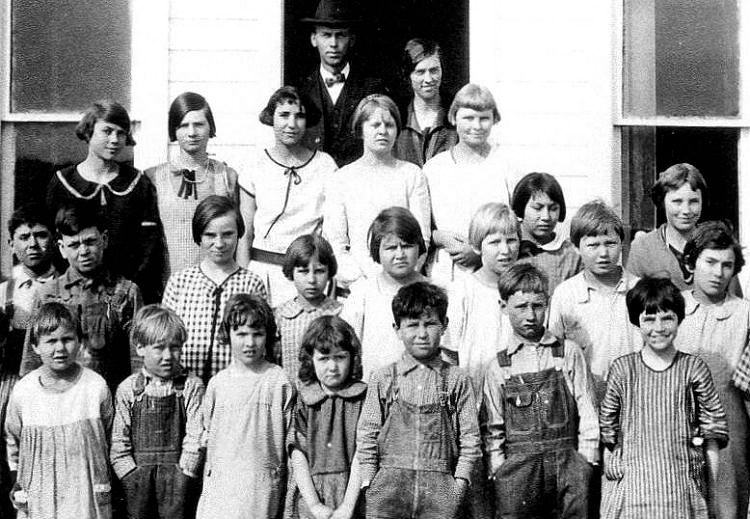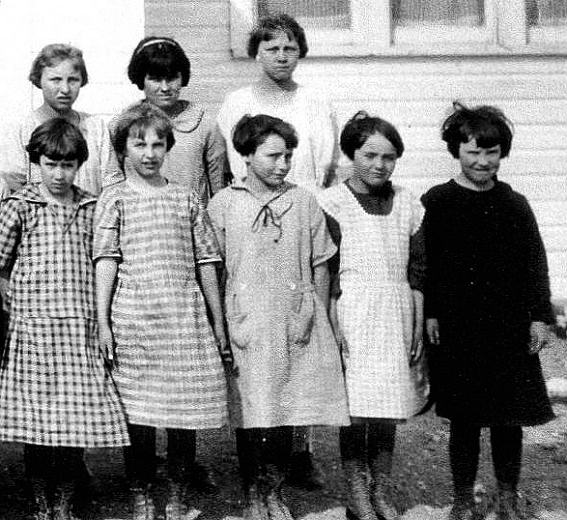

Do you know who the teachers standing in the doorway are?
Sections of the photograph are provided below with the names of the children.
Left Side

Front: Lloyd Haver, Wilma Murrain, Leona Atherton and Annie Anderson.
Second: Harold Klusman(?), Lloyd Mathies, John Trunde, Robert Biggs, Howard Crowley and Charles Crowley.
Middle Section

Front: Annie Anderson, Irvin Mathies, Martha Mathies, Ella Mathies, Vernon Wright, Raymond Mathies and Lucille Atherton.
Second: Charles Crowley, Paul Atherton, Mildred Trunde(?), Esther Wright, Lorraine Stafford, Elnora Anderson, Mildred Anderson (between 2nd and 3rd), Rosa Mathies and Waneta Wright.
Third: Gladys Murrain, Esther Anderson, Lorena Bowden, Constance Anserson, Phebe Crowley, Mildred Anderson (between 2nd and 3rd), and Martha Vonderwakl.
Back: Unidentified teachers. Do you know who they are?
Right Section

Front: Irene Mathies, Thelma Montgomery(?), ? , Vada Cook and Velma Murrain.
Second: Stella Trunde, Vera Biggs and Thora Anderson.
THE HISTORIC BLACH SCHOOL Once upon a time in rural America, the old country school was more than just a small building on the Great Plains. It represented a symbolic promise made to millions of homesteaders that their children would have access to a public education no matter where they broke sod, raised cattle, built fences or put down roots. As a result, multiple generations of Americans learned how to read and write - and add and subtract - while huddled around a hot stove on long winter days with a chalk-dusted blackboard serving as a backdrop. Unfortunately, most of these old structures have disappeared, ravaged by decades of relentless wind, rain and snow. Or, worse, some have simply been forgotten in fields and pastures now occupied by cornfields and cattle. A small number remain, however, saved by the preservation efforts of local communities and individuals who were determined to protect these relics of the past, while celebrating the vital role they played in the settlement of the western prairies. When the first wave of immigrants and settlers began arriving in northeastern Colorado in the 1880s, construction had already begun on dozens of these small schools. Twenty small schools were open and teaching local children in Yuma County by 1890. As the rising tide of settlers and homesteaders increased, so too did the demand for more schools and teachers. By 1916 there were 109 rural country schools in Yuma County with a total enrollment of 2,816 students. By comparison, student enrollment in Yuma County's public schools last year was 1,788 - Yuma (807), Wray (627), Idalia (226) and Liberty (80). The large number of rural students and schools a century ago was not an anomaly. It was the rule in rural counties across the High Plains. The old District 35 School was among a handful of country schoolhouses opened in the area after the town of Yuma was incorporated in 1887. Like many other remote schools, it was a single-room structure divided down the middle by an accordion-like door. One side served as a classroom and the other a temporary living quarters for the teacher. District 35 served the many farm families that had broken prairie sod about a dozen miles northeast of Yuma. Due the large number of students from one particularly prodigious family, it soon became known as the "Blach School." According to one of the school's alumni, Harold Blach, the schoolhouse not necessarily a permanent structure in its early years. In fact, its location was determined at the start of every school year by the student population. "Pioneers every year would survey the area [farms] for children going to school in District No. 35. So where this majority of children lived, then the parents would move the schoolhouse [closer] by teams of horses for that year." For a time the Blach School found a permanent home on the northeast corner of Section 28 in the 1930s. For two more decades at this location classes continued. But changes came when America's rural population began to shift once again after World War II. Small rural school districts began to consolidate and the one-room schoolhouse disappeared from the landscape altogether. In the late 1970s when Curtis and Betty Franson purchased the ground where the old District 35 School was located, a local preservation effort began. Recognizing its historical value, the Franson Family donated the deteriorating building to the Yuma Museum. The old building was moved one last time to its current location near the Yuma Community Center on land leased to the nonprofit museum. There it was restored to its original condition through various fund-raising events and through the generous and continuing donations from the Franson Family. The school's first teacher in 1890 was a young woman named Sadie Kessinger; its last, Alice Bishop, when the old country school held its last classes for 1st through 8th grades in 1958. The next school year, the students had to travel to Yuma. "I attended this school from 1955-1958, finishing 3rd grade when the school was closed," says Tom Blach. Getting to the old Blach Schoolhouse on time was always an adventure, Harold Blach remembers. "To get to school we would rides horses, cycles or walk. The [underage] Blach children drove a 1934 Chevy and would haul water for school every day in a three-gallon cream can." Blach children filled many of the small desks over several generations. Between 1920 and 1946 alone, there were 15 siblings and cousins attending the school. And in 1905 the first generation of Blachs began attending the school, including Ambrose, Anna, Eva, George and Herman, the sons and daughters of Wenzel and Katherine Blach, the Austrian immigrants who broke ground on the historic "Blachburg Ranch" in 1887 where Harold and his wife, Dorothy, still reside today. Of course, children from many other early settlers also attended the school. The "neighborhood roster" included many familiar last names - Anderson, Baker, Buchanan, Crowley, Dilka, Korf, Luellen, Mathies, Price, Schmale, Simmering, Trunde, Vonderwahl and Wright. Obviously, the rise and fall of the one-room country schoolhouse mirrored the feast-or-famine nature of agriculture across the Great Plains. From the Canadian Prairie to the Texas Panhandle, generations of farmers suffered through crippling droughts and other hardships that modern residents might have a difficult time imagining. In northeastern Colorado at turn of the 19th Century, for example, drought conditions and massive swarms of ravenous Rocky Mountain locust left fields completely barren. The U.S. Census indicated that the county's population plummeted, as a direct result, to less than 1,700 people by 1910. Passage of additional homestead incentives and cheap land prices brought people back onto the high plains, a fact reflected in the number of students enrolled in rural schools. Census numbers show that Yuma County's overall population had skyrocketed to almost 14,000 residents by 1920. Then the next drought cycle arrived, the one they called the Dust Bowl and another mass exodus began. The ebb and flow of the nation's population and demographics - along with its rural public education system - continued over the next several decades. Yet despite the many hardships and obstacles, good memories of the one-room country schoolhouse remain fresh today in the stories of early residents like Harold Blach who recall a much simpler life but a far more challenging time in America's heartland. Local residents are encouraged to come visit the historic Blach School this coming spring after housekeeping and renovation efforts are completed inside the Yuma Museum. |
Return to Yuma County Data